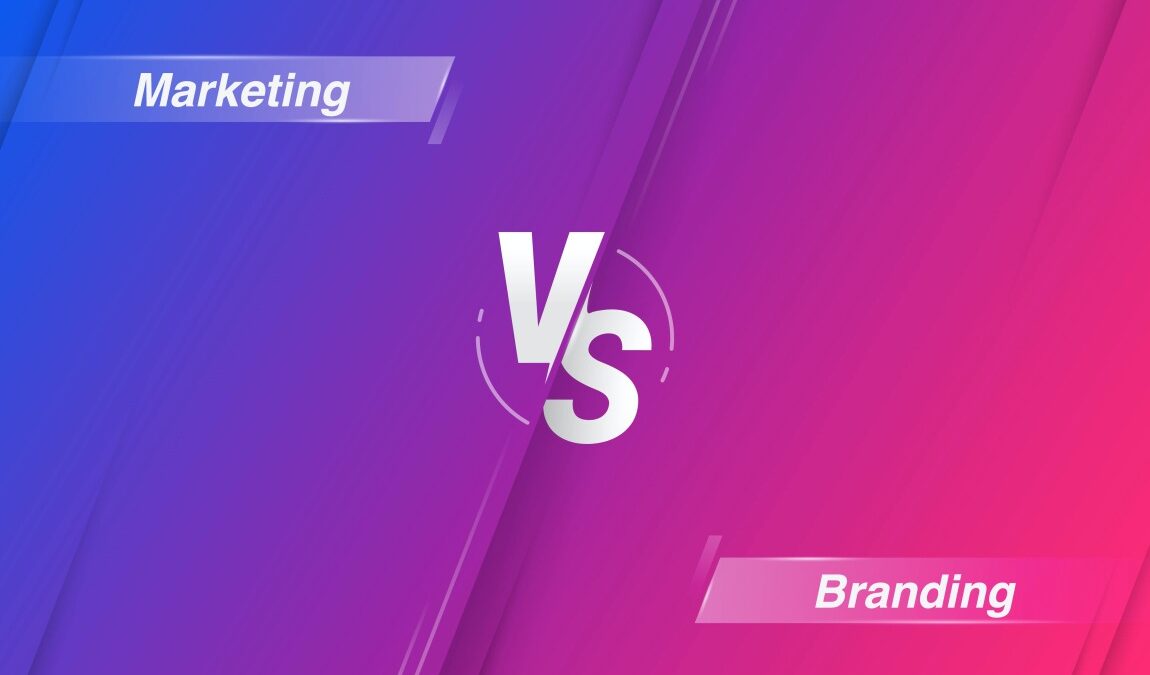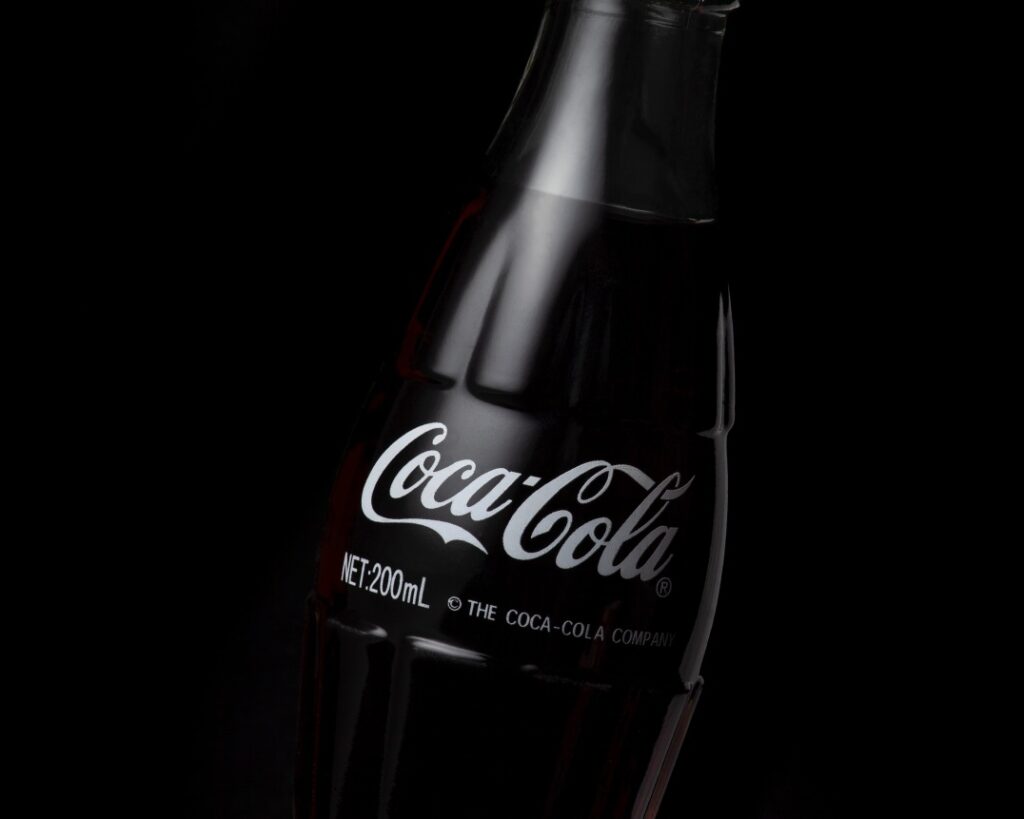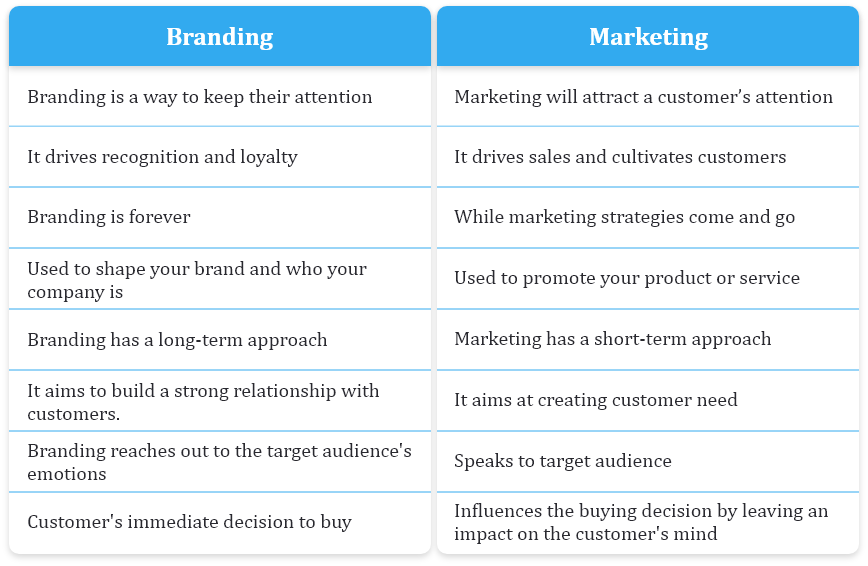Marketing and branding are the two key business functions that work together to increase your sales and revenue. Both are closely interconnected, but there are many differences between them. The pair is equally important but creating a brand identity precedes promoting it.
Marketing involves activities in which you try to sell your company’s products or services. At the same time, branding encompasses activities that create a name or an image of a product or service by occupying a place in the minds of your target audience. You send out marketing campaigns to prospects so they can choose your brand over your competitors, whereas branding helps you build long-term relationships with the prospects.
Knowing how to use both simultaneously can help you better execute specific campaigns with branding or marketing goals and build a strong foundation for your company’s future marketing activities. So, if you want your company to succeed, then you need to learn ways to effectively use marketing and branding in a way that will take your business to the next level.
So, what are the differences between marketing vs. branding?
Marketing and branding must work hand in hand to achieve those sales goals. But how you ask? In this article, we will break it down for you.
What is Branding?
Before we get into branding, let us explain what a brand is. A brand is a name, logo, sign, slogan, or a combination of those used to recognize or differentiate a company, product or service from each other. Branding is a marketing practice that includes activities for creating a memorable image of a product or service in the customers’ mind. It helps you establish trust, reinforces the value of a product or service and enhances the B2B customer experience.
Branding is a practice that shapes your company’s identity in the minds of your target. Once you create a brand recognition for your company, it will get a character and provide meaning to their customer experience. A brand is usually recognized with elements such as your logo, color palette and fonts. But in order to determine who your brand is, you need to find answers to questions like:
- What are your company’s core principles and values?
- What is the mission statement of your company?
- What are the pain points your products and services are trying to solve?
- What is the USP (unique selling point) of your products and services?
- What is your brand’s personality?
- What inspired you to build your business
- What do you want your target audience to think about your company?
Examples Of Branding Are:
Nike – When you hear Nike, you automatically remember, “Just Do It.” You can tell Nike has built its branding around athletes that try to conquer anything and keep moving forward. Their logo represents their branding elements which are motion and speed.
Coca-Cola – Coca-Cola worked for many years to create branding elements like joy, refreshment, fun, happiness, and sharing. It now has a global branding message of being a part of the happiest moments of your life. It has come up with numerous creative campaigns and promotes its visual elements to ensure it creates an emotional connection with its audience.
Do you need help with your branding and marketing strategies?
Contact Growth Hackers
What is Marketing?
Marketing is the management process that uses tools, techniques, and strategies to deliver your brand message and promote its products or services. It encompasses activities such as exploring, creating, advertising, and selling to connect with your customers and sell them your products or services. These activities are done not only to acquire customers but also to build trustful relationships and grow your business.
Some ways you can do this is by strengthening your website and presence on social media sites, as it will help you establish a robust online presence. But you must remember that how you execute your marketing strategy depends on how you define your branding strategy. While planning a marketing campaign, you must remember to direct your target audience in the right direction while supporting the core values of your brand.
The most commonly used marketing strategies are: SEO, Content Marketing, Social Media Marketing, Mobile Marketing, Email Marketing, Television, Pay Per Click Marketing, Radio, Podcast, and Print Campaigns. The questions you should ask when it comes to marketing are:
- What are the future goals of your company?
- Who are your target audience and target market?
- What are the wants and needs of your target audience?
- What are your competitors doing?
Let’s check how the same companies use marketing, and you will be able to understand the basic differences between branding and marketing.
Examples of Marketing are:
Nike – One of Nike’s well-known marketing campaigns was the ‘Find your Greatness’ Campaign in 2012. This campaign focused on everyday athletes and coincided with the 2012 Olympic games in London. This campaign empowered its target audience by telling them that it’s more about personal achievements than championship trophies.
Coca–Cola – The most popular and successful marketing campaign is the ‘Share a Coke’ campaign of 2011. This campaign involved changing the traditional wrapping around the Coca-Cola bottle to say ‘Share a Coke with…’ and a personalized name. This campaign was based on the idea of how one person can share moments of happiness with friends and family with a bottle of coke.
Misconceptions on Marketing and Branding
Branding Misconceptions
Branding is not the same as advertising
Branding projects used to be handled by advertising agencies but are not anymore, as companies have a separate team that has expertise in branding. It is a long-term endeavor whereas advertising usually focuses on short-term campaigns.
Branding is not just for big MNC companies
There are numerous small businesses that have increased the number of customers or website visitors just by working on their brand. Any company can use good branding to grow and maintain their position in their industry or market.
Branding is not just about how things look
The visual identity of a brand and its overall design aesthetics play a vital role in creating a good brand. But branding goes way beyond just the visual identity as it also includes other aspects of your company such as management to communications.
Marketing Misconceptions
Marketing’s role is only to generate new customers
This is not right because not only does it generate leads but also for providing stellar customer support, deals, and other incentives. It also is used for promoting any new product or services that your company launches.
Good marketing efforts can deliver fast results
Yes, good marketing can get you good results but it does not happen fast and usually takes months to see big gains. Marketing is a long-term commitment, especially for marketing methods such as content marketing and SEO.
Don’t need an agency because marketing is easy
One of the common misconceptions about B2B marketing is that everyone can do it and doesn’t require any help. Now this is wrong because if you want to launch a big marketing campaign you can get professional help to get better results.
Which comes first, Marketing or Branding?
As you saw from the Nike and Coca-Cola examples above, these companies were successful with their marketing campaigns because they took the time to perfect their branding strategy. These companies could easily communicate their purpose with their target audience and now their audience remembers the brand and associates it with its brand elements.
To summarize it, we can say that branding is the core of your marketing strategy and so it must come first! You have to define who you are as a brand before you deploy your marketing campaigns because a brand is what will keep your clients coming back for more. Branding acts as a foundation on which marketers build consumer loyalty. If you don’t have answers to who you are as a brand, what your core values are or don’t know what you bring to the marketplace then you can’t start marketing your product. Which is why Branding comes first!
The marketing methods or strategies tend to change from time to time, but branding remains the same, your core principles, mission, or values, as it must be consistent. It is something that requires your team to work on every purchase, every phone call that is received, and an email that is responded to on a daily basis. Whereas marketing campaigns can only be planned for a specific duration of time.
So, once you have your branding in place, you will better understand your company, your target audience, the target market and the best ways to connect with them and convert them into your customers.
Now is the time to work on both your branding and your marketing!
Differences Between Marketing and Branding
Even though branding and marketing are used simultaneously, they both have different goals and results. A good branding and marketing company must be able to craft strategies around a long-term business plan and keep its brand relevant for years to come. Since the brand identity is consistent, it allows you to build long-lasting relationships with your customers.
Marketing activities on the other hand, are constantly evolving and depending on the brand, you may consider online or traditional marketing avenues. A multi marketing strategy can grab your audience’s attention, but branding keeps it. You should know that branding is said to have just as much of an impact on your team as it does on your customers. If we talk about value, marketing promotes intended value, but branding helps you create one.
Marketing may have to power to get your brand in front of your target audience, but you need to build a brand that people can connect with. So, in a nutshell, we can say that marketing is for business while branding is done for customers.
How Can Branding and Marketing Work Together?
While creating marketing campaigns, you implement key branding elements in design like the company logo, color palette, and more. Since branding can naturally bring together a community, you can use marketing to nurture that connection. You can find out what your target audience values and the best channels that you use to reach out to them. If you focus on balancing branding and marketing priorities, then you can easily reach the ultimate goal of growing your business.
End Note on the Differences Between Marketing and Branding
If the difference between marketing and branding is clear, you can go in the right direction and increase your sales by planning your marketing campaigns. Remember that you can achieve success without branding, but your success will be far more substantial with a brand identity. Understanding the major differences between marketing and branding will help you build your company’s foundation. So, what are you waiting for? Get out there, build your brand identity and start planning your marketing campaigns.
Growth Hackers is an award-winning growth marketing company helping businesses from all over the world grow. There is no fluff with Growth Hackers. We help entrepreneurs and business owners create and utilize marketing and branding strategies, generate qualified leads, optimize their conversion rate, gather and analyze data analytics, acquire and retain users and increase sales. We go further than brand awareness and exposure. We make sure that the strategies we implement move the needle so your business grow, strive and succeed. If you too want your business to reach new heights, contact Growth Hackers today so we can discuss about your brand and create a custom growth plan for you. You’re just one click away to skyrocket your business.







